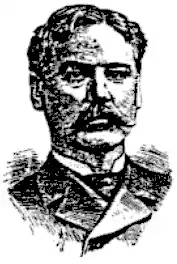Charles DeKay
Charles Augustus de Kay (July 25, 1848 – May 23, 1935) was a linguist, poet, critic, and fencer. He was a son of George Coleman De Kay, a naval officer.[2]
Charles Augustus de Kay | |
|---|---|
 | |
| Born | July 25, 1848[1] Washington, D.C., US |
| Died | May 23, 1935 (aged 86)[1] New York City, US[1] |
| Alma mater | Yale[1] |
| Employer | The New York Times |
| Spouse | Edwardlyn Coffey[1] |
| Children | 8 |
| Signature | |
He graduated from Yale College in 1868.[3]
He was best known for founding the National Sculpture Society, the Authors' Club, the National Arts Club and the Fencers Club.[1][3] He was inducted into the United States Fencing Hall of Fame in 2008. He was an art and literary critic for The New York Times for 18 years. He was a co-founder of the Circle of Friends of the Medallion.[4]
He also wrote under the pseudonyms "Henry Eckford"[4] and "Louis Barnaval".[5]
In June 1894, he was nominated by Grover Cleveland to be Consul General at Berlin[3] and took over the post shortly thereafter.[6] In keeping with his lifelong love of fencing, he had the honor of opening the fencing club in Berlin while serving as Consul General.[7]
He was buried in Saint George's Church Cemetery, Hempstead, New York.
Writing
- The Bohemian (New York, 1878)[8]
- Hesperus (1880)
- Vision of Nimrod (1881)
- Vision of Esther (1882)
- Love Poems of Louis Barnaval (1883).
- Bird Gods, with an accompaniment of decorations by George Wharton Edwards. New York : A.S. Barnes (1898).[9]
- Life and Works of Barye[10]
- Life and Works of Louis Comfort Tiffany[10]
According to Appletons' Cyclopædia (1900), his best-known story is "Manmatha".[2]
References
- "Brief Biography of Charles deKay" Archived July 17, 2011, at the Wayback Machine, United States Fencing Hall of Fame website. Retrieved on December 02, 2010.
- Wilson, J. G.; Fiske, J., eds. (1900). . Appletons' Cyclopædia of American Biography. New York: D. Appleton.
- "NEW CONSUL GENERAL AT BERLIN.; Charles de Kay of This City Appointed by the President -- Other Nominations". The New York Times. June 27, 1894. ISSN 0362-4331. Retrieved July 7, 2022.
- Homren, Wayne (editor). "Numismatic Writer Charles De Kay", The E-Sylum, volume 5, number 43, October 27, 2002, Article 4. Retrieved August 29, 2021.
- Barnaval, Louis, in Who's Who in America, 1901-1902 edition; p. 58; via archive.org
- "CHARLES DE KAY THEIR GUEST; DINNER GIVEN TO THE CONSUL GENERAL TO BERLIN. Members of The Fencers' Club, The Authors' Club, The Sculpture Society, and Other Personal Friends Bid the New Official Farewell -- Repast Served in True German Style in Liederkranz Hall -- German Con- sul and Others Make Speeches". The New York Times. August 31, 1894. ISSN 0362-4331. Retrieved July 7, 2022.
- "BERLIN HAS A FENCING CLUB.; Charles de Kay and Lord Granville Do the Honors at the Opening". The New York Times. January 26, 1896. ISSN 0362-4331. Retrieved July 7, 2022.
- "A NEW STORY.; THE BOHEMIAN, A Tragedy of Modern Life. By CHARLES DE KAY. New-York; CHARLES SCRIBNER'S SONS". The New York Times. January 6, 1879. ISSN 0362-4331. Retrieved July 7, 2022.
- De Kay 1898: OCLC 1065202268 (all editions) (see also: OCLC 1087093329 (all editions) etc.); digital copy at Internet Archive; digital copy at University of Michigan.
- "CHARLES DE'KAY, 8.6, POET, CRITIC, DEAD; Prominent in Literary, Art and Social Circles Many Years-Former Envoy to Berlin. A LINGUIST AND A FENCER Editor and Writer With The Times 1876-94 Member of a Distinguished Family". The New York Times. May 24, 1935. ISSN 0362-4331. Retrieved July 7, 2022.
External links
- Works by Charles DeKay at Project Gutenberg
- Works by or about Charles DeKay at Internet Archive / Works by or about Charles DeKay at Internet Archive
- Works by Charles DeKay at LibriVox (public domain audiobooks)

- Louis Comfort Tiffany and Laurelton Hall: an artist's country estate, an exhibition catalog from The Metropolitan Museum of Art Libraries (fully available online as PDF), which contains material on DeKay